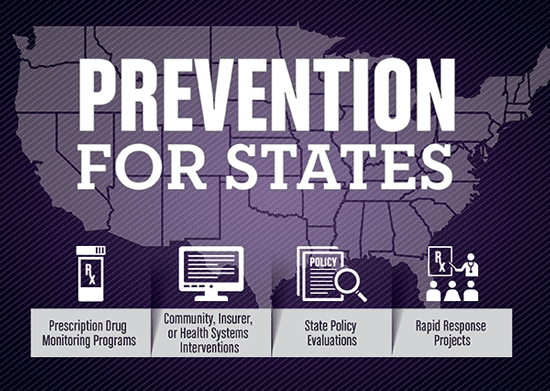Prevention for States
Prevention for States Supplemental Funding
As a result of increased funding in 2016, among the 29 PfS states, 14 are now receiving additional dollars in one-year supplemental funding to support their ongoing work. The states receiving supplemental funding are: California, Colorado, Indiana, Kentucky, New Mexico, New York, Ohio, Oregon, Pennsylvania, Rhode Island, Tennessee, Utah, Washington, and Wisconsin.
Prescription Drug Overdose: Prevention for States is a program that helps states combat the ongoing prescription drug overdose epidemic. The purpose of Prevention for States is to provide state health departments with resources and support needed to advance interventions for preventing prescription drug overdoses.
Funded States
Through a competitive application process, CDC selected 16 states to receive funds through the Prevention for States program (see map). With this funding received in September 2015, participating states began executing and evaluating prevention strategies to improve safe prescribing practices and prevent prescription drug overuse, misuse, abuse, and overdose.
In March 2016, as part of the effort to move toward a national program, while still ensuring sufficient investment in states with the highest burden of PDO, an additional 13 states were funded under the Prevention for States umbrella. These states were previously “approved but unfunded” and are among the states with the highest burden of PDO. With the addition of these states, CDC is now reaching a total of 29 states with the Prevention for States program.
Priority Strategies and Activities

Through 2019, CDC plans to give selected states annual awards between $750,000 and $1 million to advance prevention in four key areas. Awarded states are collaborating with key partners to maximize efforts and address issues that impact prescribing and drug overdoses. Examples of states’ activities include:
Maximizing PDMPs
- Moving toward universal registration and use
- Making PDMPs easier to use and access
- Making PDMP data more timely
- Expanding and improving proactive PDMP reporting to identify and address inappropriate prescribing patterns
- Using PDMP data to better understand the nature of the prescription drug overdose epidemic
Community or Insurer/Health Systems Interventions
- Providing technical assistance to high-burden communities and counties
- Improving opioid prescribing interventions for insurers and health systems
- Enhancing use of evidence-based opioid prescribing guidelines
Policy Evaluations
- Evaluating interventions to better understand what works to prevent prescription drug overdoses
Rapid Response Project
- Implementing a project to advance an innovative prevention approach and respond to new and emerging crises and opportunities
Impact
The Prevention for States program includes evaluation of awarded states’ program activities to monitor performance, demonstrate effectiveness, and capture success stories. Results and project successes will determine the impact of this program and inform future state and national efforts in preventing prescription drug overdoses.
Historical Spotlight: Prevention Boost
Prescription Drug Overdose: Boost for State Prevention (Prevention Boost) was an initiative where CDC's Injury Center equipped five state health departments—Kentucky, Oklahoma, Tennessee, Utah, and West Virginia—with resources and scientific assistance to prevent prescription drug overdoses. Funding was provided to advance prevention in three key areas: (1) maximizing the use of PDMPs; (2) improving public insurance mechanisms to protect patients; and (3) evaluating policies to identify prevention that works. The current PDO Prevention for States program was created to scale up this work, funding three times as many states and making larger investments to fully implement the ambitious prevention strategies essential to reversing the epidemic.
Funded States Map
- Page last reviewed: August 30, 2016
- Page last updated: August 30, 2016
- Content source:
- Centers for Disease Control and Prevention,
- National Center for Injury Prevention and Control,
- Division of Unintentional Injury Prevention


 ShareCompartir
ShareCompartir
